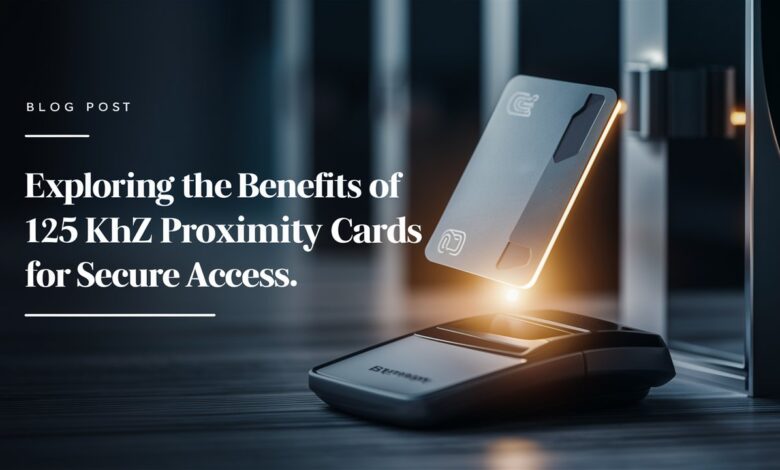Exploring the Benefits of 125 kHz Proximity Cards for Secure Access

These proximity ID cards, often referred to as prox cards, have become a familiar sight in office buildings, universities, and various facilities worldwide. They offer a contactless method of granting access, allowing users to enter secured areas with a simple wave of their card near a reader. This technology has fundamentally changed how many organizations manage access to their premises, offering benefits in terms of convenience and management.
However, as with any technology that has been in use for an extended period, questions arise about its continued relevance and effectiveness. In an era where digital security threats are ever-present and evolving, it’s crucial to examine whether 125 kHz proximity cards still meet the security standards required by modern organizations.
What Are 125 kHz Proximity Cards?
125 kHz proximity cards, often called prox cards or proximity ID cards, are a type of contactless credential used for access control. They use RFID (Radio Frequency Identification) technology to communicate with card readers at a low frequency of 125 kHz. This technology allows for quick and easy access to secured areas without the need for physical contact between the card and the reader.
The ISO PVC proximity card has been a staple in access control for over 25 years. Its longevity in the market is a testament to its effectiveness and ease of use. However, as we’ll explore later, this long-standing presence also raises questions about their security in the face of modern threats.
How Do They Work?
A 125kHz proximity card contains a small antenna and a microchip. When the card comes within range of a compatible reader, the reader sends out an electromagnetic field. This field powers the card’s microchip, which then transmits its stored data back to the reader. This process happens in a fraction of a second, allowing for quick and seamless access.
The data stored on these cards typically includes a unique identifier, often consisting of a site code and a card number. When the reader receives this information, it sends it to the access control system, which then determines whether to grant or deny access based on predefined permissions.
Read More Articles: Exploring the Different Types of Office Cleaning Services in NYC
The Upsides of 125 kHz Prox Cards
Convenience
One of the biggest selling points of 125 kHz proximity cards is how easy they are to use:
- No more fumbling with keys or swiping cards
- Just get close to the reader, and you’re in
- Quick access makes them great for high-traffic areas
Built to Last
A proximity smart card is tougher than you might think:
- No physical contact with readers means less wear and tear
- More durable than traditional keys or magnetic stripe cards
- Can withstand being carried around in pockets or bags
Easy to Manage
For administrators, a 125kHz proximity card offers some handy benefits:
- Quick to add or remove access permissions
- Great for businesses with high turnover or complex access needs
- Integrate smoothly with many existing security systems
Budget-Friendly (Sort Of)
For a long time, 125 kHz proximity cards were seen as a cost-effective option. While newer, more secure alternatives are now similarly priced, these cards can still be an economical choice for some organizations.
Familiarity Factor
Because they’ve been around for so long, many people are already used to 125 kHz proximity cards. This familiarity can make implementation and user adoption smoother in some cases.
The Downsides: Security Concerns
While 125 kHz proximity cards have their perks, they also come with some significant security drawbacks that are hard to ignore.
Lack of Encryption
The biggest issue with 125 kHz proximity cards is their lack of encryption:
- Card information is stored in plain text
- Vulnerable to cloning and unauthorized access
- Data can be easily read and copied using cheap, readily available devices
Read More Articles: The Importance of Regular Carpet and Upholstery Cleaning in NYC Offices
Limited Data Storage
125 kHz cards don’t hold much information:
- Typically only store a site code and card number
- Limited to about 16.7 million possible combinations (in 26-bit format)
Easy to Clone
The ease of cloning 125 kHz cards is a major security risk:
- Cards can be duplicated in seconds with inexpensive tools
- Some devices can even read card data from a distance without the user knowing
Outdated Technology
In the fast-moving world of security tech, 125 kHz proximity cards are showing their age:
- Developed over 25 years ago
- Lack of the advanced security features of newer technologies
Alternatives to Consider
Given these security concerns, many experts recommend looking at more secure options:
- 13.56 MHz Smart Cards: These higher-frequency cards offer better encryption, and more storage, and are harder to clone.
- Mobile Credentials: Using smartphones for access control is becoming popular, offering high security and convenience.
- Biometric Systems: Options like fingerprint or facial recognition provide top-notch security without physical credentials.
The Bottom Line
While they might still be a decent choice for low-security applications, organizations handling sensitive information or valuable assets should seriously consider more secure alternatives. Bristol ID Technologies has a lot of better technologies available.
Remember, the best access control system is one that balances security, usability, and cost-effectiveness for your specific needs. Don’t be afraid to explore newer technologies that could offer better protection for your organization in the long run.




